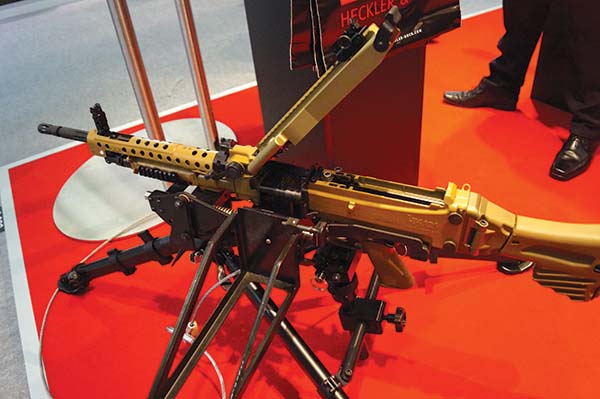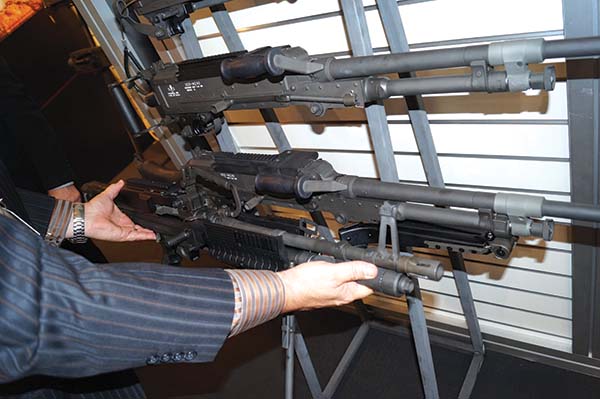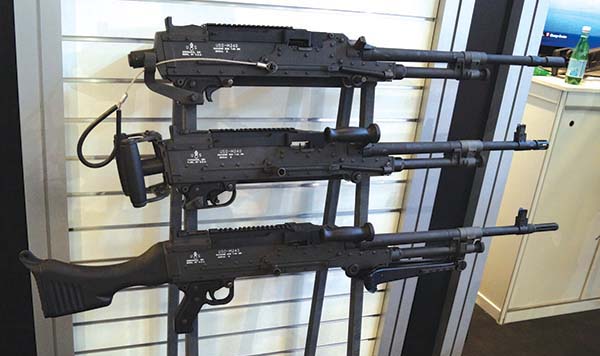ABOVE: MG5 A2 (HK121) is the new MMG for the German defense to replace their aging MG3 machine guns. It is being promoted by H&K in a number of different configurations. The MG5 on the photo has a new generation of targeting sight: AIM HuntIR MK 2 (Photo: Heckler & Koch)
Trending Away from 5.56mm
There’s a global trend of moving away from the 5.56mm round for everything but assault rifles. Troops operating on the ground in Afghanistan have called for a lighter, more mobile machine gun with more hitting power than a 5.56mm LMG. The 5.56mm caliber weapons have received criticism for lacking sufficient stopping power at longer ranges, but the heavier GPMG and its ammunition can be cumbersome for long foot patrols in hot climates.
German Defence Replaces MG3s with the MG5
The German Federal Defence (Bundeswehr) will, in their long term plans, procure 12,733 MG5 systems as replacements for the MG3s. There is some controversy surrounding the Heckler & Koch MG5, but the contract is still moving forward.
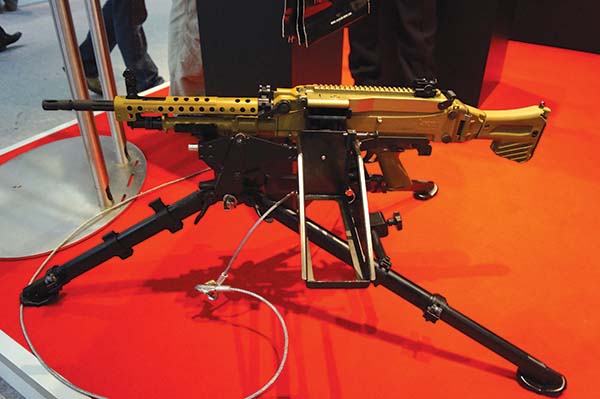
MG5 Features
The MG5 is an air-cooled, belt-fed, gas-operated weapon with a positively locked rotary bolt head and long-stroke gas piston system. Compared to its predecessor (the MG3), the MG5 has a distinctly different frame, a free barrel and lower weight, making it much easier to carry and operate than the MG3. Its light weight makes shooting it in standing position almost as easy as lying down. MG5s consist of two molds of cast steel as well as a single adjoining block. These parts are then connected through a special patented procedure. This does not necessarily save weight, but it makes the weapon stable for use as a universal MG. The robust, cold forged barrel (covered with a special protective layer) looks quite imposing.
The MG5 can endure 1,500 rounds in a frequent firing regime. There is significantly less danger of the barrel overheating or accidental discharge from an overheated chamber; it can happen only after 300 DM111A1 rounds are fired and if the ambient temperature is greater than 20°C. MG5 does not require frequent barrel replacements during a firefight (as was the case with many older machine guns). The barrel can be replaced quickly and easily without assistance and the task can be completed in just a few seconds, without the need for protective gloves. It enables, for example, an infantry soldier to change the barrel in standing position, saving a few seconds.
MG5 has a durability of 50,000 rounds per housing and in tests, according to the company, far higher exposure limits have been reached. Heckler & Koch offers barrels in three lengths: standard 550mm, infantry 460mm and mounted (Einbauwaffe – EBW), 663mm. MG5 uses delayed recoil and has a locked seal with a rotating bolt and a gas piston. Ammunition is belt fed from the left side of the weapon. Loading is easy and requires little strength. MG5 has an ambidextrous selector lever and it can be easily turned off or on, whether it’s loaded or not. This is the first machine gun in the world to offer that capability. For additional security, it uses an indicator that shows the loaded state, if there’s a single bullet in the barrel this indicator pokes out of the housing cover, that way the shooter can both see and feel it. Also, if a bullet jams in the barrel, the next bullet will force it out without the barrel bursting in the process. And most importantly, tests have proven that the weapon continues with normal operation afterwards.
While the effective combat range of MG5 is 600m, it can shoot accurately up to 1,200m when mounted. H&K guarantees the shooting diameter of 30cm in single fire mode at the distance of 100m, with 10 fired rounds of soft core DM111A1 ammunition. For the sake of comparison, MG3 would make a 59cm diameter beaten zone at the same distance. HK121 (MG5) has made significant improvements concerning machine gun accuracy. MG5 can fire in three different modes: 600, 700 and 800 RPM. Rate of fire can be changed quickly and without any special tools, just by changing the amount of gas released. The slower rate of fire significantly increases both accuracy and the service life of the weapon, making it more than a worthwhile compromise; especially if one takes into consideration reduced bullet consumption, often a critical factor in combat situations when an infantry group needs to hold position for an extended period of time.
MG5 Designation and Accessories
The housing cover of MG5 has long NATO STANAG rails, which allow for mounting of all electronic and optical sights, including night vision accessories. The cover itself is strong enough to bear significant weight, i.e. everything you can think of putting there. The H&K machine gun can adapt to various personal preferences and requirements. Various barrels, folding and telescopic stocks, armguards (with or without levers), bags for empty bullet casings and bags with rolled 50 to 100 round ammo belts. The designers have resolved the problem of easily misplaced small parts. H&K offers the machine gun in the mounting variant, with a far more resilient barrel, greater muzzle velocity and range of up to 1,500m.
Denmark Chooses the M60E6
The Danes have been fighting in Afghanistan where they have also been involved in some of the heaviest fighting. Consequently, the Danes have gained a lot of experience with machine guns. They’ve learned that the best machine guns combine agility with stopping power and accuracy. The Royal Danish Army’s experiences in Afghanistan made reduced weight and high mobility key factors for a new squad MG, with the replacement program’s four main requirements being weight, ergonomics, firepower and accuracy. Integration with the Royal Danish Army’s current equipment, including the M12 ballistic protection vest, was also included in the evaluation process.

What the Danes wanted in this specific project was a lightweight machine gun in 7.62×51 NATO for mobile infantry. The tender process with a total need of 700 pieces began in early 2013. The MG5 and the U.S. Ordnance M60E6 set themselves against the other candidates. The Danes selected two candidates to replace its aging LMG 7.62mm M/62 (MG3) squad support weapons and conducted trials on the Hecker & Koch MG5 (HK121) and U.S. Ordnance M60E6. After the trials, the Danes chose the M60E6. It will be used as a squad support weapon, with the older LMG M/62 remaining in service with second-line units and as a vehicle-mounted machine gun, where weapon weight is not as important. U.S. Ordnance is the only company that makes the M60E6. The estimated cost of the program is $16.6 million for 700 M60E6s with accessories. The M60E6 is planned to be phased into service at the end of 2014. Additional equipment for the M60E6 may include daylight optics, night thermal sights, laser designator and laser rangefinder.
Features of the M60E6
This version is a heavily-upgraded (and intimidating) weapon from the past, an upgraded version of the M60, the famous 7.62 NATO caliber MG first used in combat by U.S. forces during the 1960s. The M60E6 can be equipped with different barrel lengths, with several standard 1913 NATO Accessory Rails for additional equipment and a sound suppressor. The short barrel version weighs 20.44 pounds, shaving off a few precious pounds from the basic M60. M60E6 is gas operated and belt fed with disintegrating link. It fires from an open bolt and features a quick-change barrel. Its design is light and compact, which provides increased mobility and allows for accurate shouldered direct fire support. The Stellite® alloy of cobalt-chromium alloys gives the barrels sustained fire and extended life. The hard chrome and induction hardening of op rod tube facilitates easier cleaning and increases the service life of the receiver. It is available in a short or a heavy fluted configuration for application flexibility.
Controllable rate of fire allows for accurate firing in offhand, kneeling, and prone positions. It has a push button, or ambidextrous, safety. All major components are directly interchangeable with other M60 configurations. The M60E6 features a machined aluminum feed cover with integrated M1913 Picatinny rail for mounting optics, infrared laser aiming devices and other sensors, giving the weapon operator day/night firing capability. The ergonomic pistol grip with an improved trigger can be used with gloves. It has a lightweight one-hand operated receiver mounted bipod and a lightweight forearm/pistol grip for improved control with (3) M1913 rails for mounting aiming lasers and accessories. The stock is ergonomic with hinged shoulder rest. It has quick detaching sling mounting points. A receiver-mounted ammunition hanger provides a stable and secure mounting point for an ammunition pouch and isolates the feed tray from accidental damage. New “captured pin” latch securely holds the trigger assembly to receiver. This version is simple and easy to maintain and has a gas system with reversible gas piston. The gas regulation is self-adjusting. The front sight is adjustable, also on the spare barrel, which was not possible in the earlier versions, and allows zeroing of primary and spare barrels. The offset barrel handle provides a clear sight picture and there is no need to wear gloves when swapping out the barrel.
Hard chrome and induction hardening of tube facilitates easier cleaning and increases the service life of the receiver. A 30% improved belt pull provides increased reliability in harsh, dirty environments. This upgraded MG fires 500-650 RPM, compared to the 1,200 RPM fired by the MG3. This saves ammo, and gives the gunner a weapon that’s easier to control along with greater accuracy. The weapon also has a second pistol-style grip below the barrel that gives it greater stability. The effective range, 1,200 yards, is the same as the standard M60.
Norway
In Norway, the MG3 will be phased out in the near future. Current vehicles, which already have an FN MAG installation, will not be replaced. The FN MAG 7.62 Standard (FN MAG) will be procured from FN Herstal as a vehicle-mounted MMG. The process of obtaining a new, lighter infantry MG is well underway. In 2015, tests of a new MMG were conducted to replace the MG3 in the ground role, and will typically be organized together with the antitank weapons squad in the rifle platoon. Actual candidates to be tested are: M240L from FN Manufacturing LCC, M240LW from Barrett and MINIMI 7.62 mm from FN Herstal.

The titanium M240L (lightweight)
After Army and Marine infantry units began employing the M240B in the mid-90s, the gun gained soaring popularity as it became known for reliability, durability and low maintenance requirements. Despite its success, however, soldiers still pointed to the added weight and length of the M240 as compared to its infantry squad’s MG predecessor, the M60. This feedback called for a remedy. After much research, FNH USA, LLC engineers ultimately settled on using a titanium alloy as the primary metal for the MMG designated M240L. Titanium is recognized for its high strength-to-weight ratio. Titanium has a relatively high melting point. Working with titanium called for adjustments to the manufacturing process. Early on, engineers experimented with welding the titanium components together, but ran into warping issues. The final solution rested in using stainless steel rivets, which are more pliable than titanium and resist corrosion when in contact with titanium. Once assembled, the weapon needed a protective coating to preserve the metal. Steel weapons typically get a phosphate coat and are subsequently oiled, but the titanium receiver required a completely different process. Titanium alloys do not rust, they gall, causing the surface to become rough and deformed over time. To solve this challenge, they researched and use coatings that protect the metal under extreme operating temperatures. They found success with a chrome carbo-nitride coating used for industrial, high-heat applications. A ceramic-based top coat is added to complete the process. The final product weighs in at just 22.3 pounds (10.1 kg), nearly five pounds lighter when compared to the M240B’s 26 pounds. To those who are familiar with the M240B, there is hardly a discernible difference in the new gun beyond its lighter weight. The M240L meets all the operational requirements of the original while maintaining the same high standards of reliability and durability.
Features
The 7.62 mm M240L’s enhancements features includes a titanium receiver, redesigned barrel assembly with re-contoured outer dimensions, titanium carrying handle, and lighter weight gas housing; and pistol grip/trigger frame assembly composed of a metal/polymer hybrid. This reduce the weight compared to the existing M240B by 18% – 20%, resulting in reduced combat load and allowing easier handling and movement of the weapon. The development of the 240L retains the 240’s reliability and toughness with less weight. In January 2012 the U.S. Army adopted the M240L equipped with a 4 inch (ca. 100 mm) shorter barrel than a standard M240 barrel, and with the collapsible stock the M240L can be made 7 in (180 mm) shorter and is equipped with the forward mounted MIL-STD 1913 rail kit. M240L short-barreled is the newest variant in service. FNH USA, LLC is contracted for three plus three thousand units. The service plans to buy around 12,000 in all of the weapons. The Army has given very good feedback reports. Sceptics claim that experience shows that wear and tear has taken away some of the coating on the receiver which means trouble. They also refer to an incident in Afghanistan under conditions with extreme outdoor heat when the gunner tried to change the overheated barrel with a “cold” one. The barrel is tightly locked in the receiver and features a quick change barrel which makes replacement of a hot barrel possible in less than 6 seconds, also during missions. In this incident, the barrel nut was stuck and the barrel was impossible to unlock due to the temperature differences between the titanium and the steel.
Barrett M240LW
Barrett Firearms, the manufacturer of firearms and ammunition, including the famous M82A1 which has been purchased by over 40 military organizations worldwide, took the initiative to make the M240 lighter and designed the M240LW taking advantage of cutting-edge manufacturing techniques. Barrett brought their lightweight M240LW prototype to the SHOT Show, Las Vegas in 2011. Unlike the M240L, which is in service with the Army, Barrett does not use any expensive materials like titanium receiver and polymer trigger frame or manufacturing techniques to decrease weight. They instead decreased weight by trimming off as much metal as feasible and decreased manufacturing costs by making the receiver in two pieces and then welding it together. They managed to trim about 4.5 pounds off the standard M240B. Most internal parts are the same as the 240B. In June 2014 the gun was in process of intensive testing.
FN MINIMI 7.62 mm x 51
In 1974 the prototype Mini-MG was in caliber 7.62 mm x 51, a MMG-version. Due to low potential in the market and that the trend went for 5.56 mm, this version was then no longer needed. At the beginning of this millennium, FN Herstal again started the development of the MINIMI in caliber 7.62 mm x 51 because USSOCOM (United States Special Operations COMmand) wanted a light MG in the heavier NATO-caliber. The 7.62 MG was adopted by USSOCOM under the MK 48 designation. Besides the standard hand guard, there is a version “Triple Rail (T.R.)” with three Mil-Std 1913-rails (“Picatinny Rails”). Alternatively one can choose between a fixed synthetic stock and a collapsible (sliding) metal stock. The weight of the FN MINIMI 7.62 T.R. Sliding Butt (8.6 kg) means that the weapon is easy to carry. Certain types of terrain or fighting in buildings may require the user to shoot from the standing position. Here again, the weight of the FN MINIMI 7.62 is a real advantage.
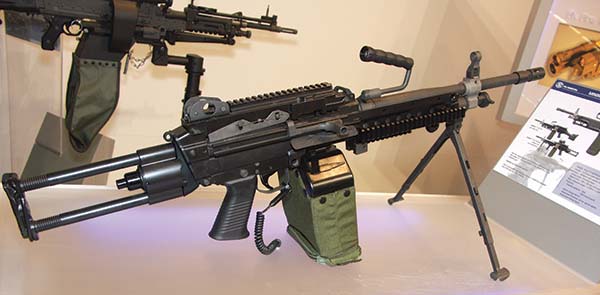
FN MINIMI 7.62 mm Mk3
The modifications introduced on the FN MINIMI Mk3 result from feedback provided by users engaged in current operating theatres. The demands of users have evolved over the past 10 to 15 years due to changes in the way the FN MINIMI machine gun is used in combat (increased use of accessories, evolution in the soldier’s equipment, and changes in tactics such as shooting from all positions – prone, kneeling and standing). The new FN MINIMI Mk3 offers the users improved ergonomics and improved mobility while retaining the same core mechanism as the previous versions, which gives a limited impact on logistics and training. Identical to the 5.56 mm version, the 7.62 mm x 51 is capable of fully automatic fire only and it can be belt fed or fired from a magazine. Mk3’s benefits are high parts commonality with the FN MINIMI 5.56 mm but it has of course higher hitting power and longer range. The modifications have resulted in a new light machine gun offering improved ergonomics and improved mobility. The new buttstock is ergonomic and adjustable in length (5 positions) to allow compensation for body armor and load bearing equipment and the stock has also a height adjustable cheek rest (4 positions). The shooter can then have his eye correctly aligned with the iron sights, or optical sights, while keeping his cheek properly positioned on the buttstock. It also integrates a folding shoulder rest and a hydraulic buffer that stabilizes the rate of fire and reduces felt recoil. It has a new hand guard/bipod assembly that provides a comfortable hand guard and three forward MIL-STD 1913 Picatinny accessory rails. The adjustable-height (3 positions) bipod, when folded back, integrates into the shape of the hand guard even with an accessory on the lower rail. The ergonomically-shaped cocking handle gives the user a better grip with the strong or weak hand. The feed tray is improved with belt retaining pawls that hold the belt correctly in position during the loading procedure, which is most useful when the user is in the standing position. There is an optional heat shield to greatly reduce the risk of inadvertently touching the barrel.
It is not known whether the U.S. Armed Forces will upgrade their M249 Light Machine Guns to the new Mk3 model because USSOCOM and the NSWC have been developing their own variants and upgrades for many years.







